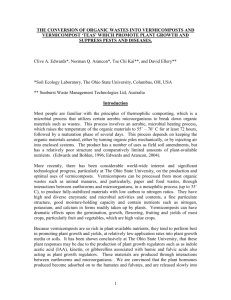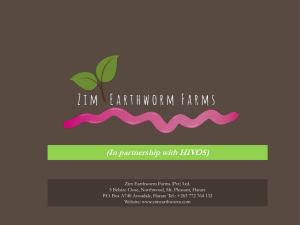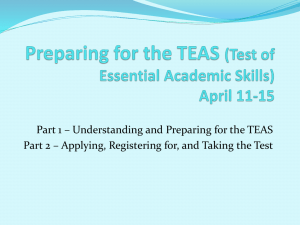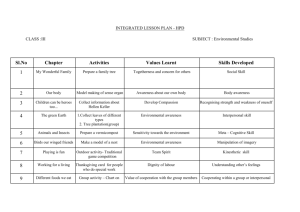suppression of plant parasitic nematodes and
advertisement
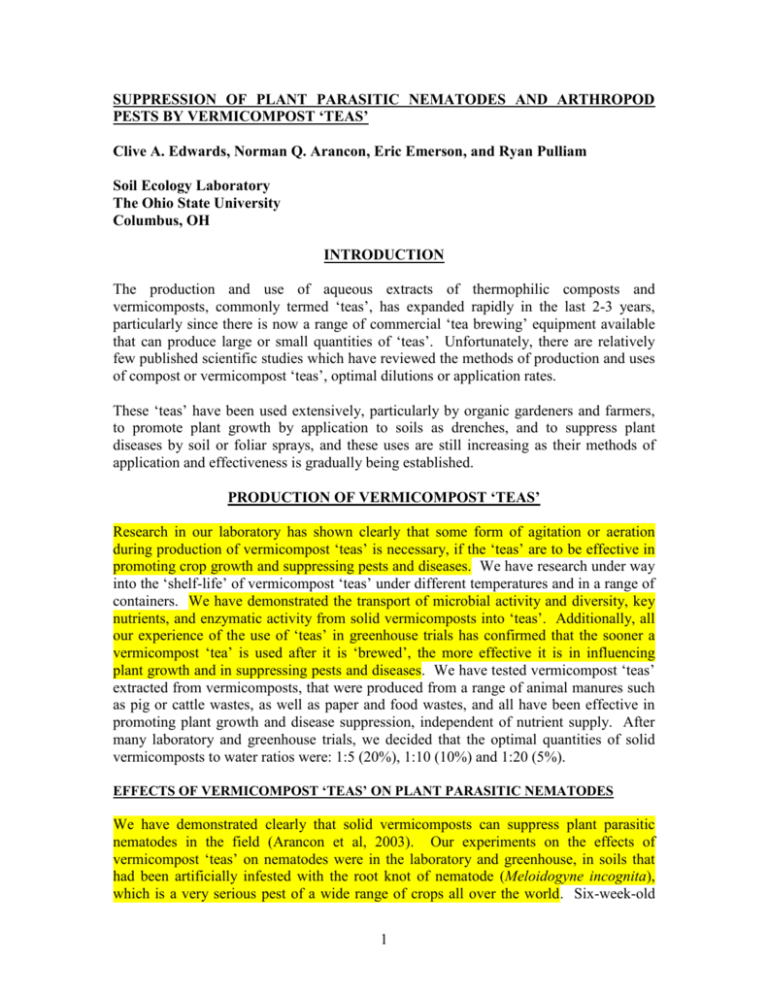
SUPPRESSION OF PLANT PARASITIC NEMATODES AND ARTHROPOD PESTS BY VERMICOMPOST ‘TEAS’ Clive A. Edwards, Norman Q. Arancon, Eric Emerson, and Ryan Pulliam Soil Ecology Laboratory The Ohio State University Columbus, OH INTRODUCTION The production and use of aqueous extracts of thermophilic composts and vermicomposts, commonly termed ‘teas’, has expanded rapidly in the last 2-3 years, particularly since there is now a range of commercial ‘tea brewing’ equipment available that can produce large or small quantities of ‘teas’. Unfortunately, there are relatively few published scientific studies which have reviewed the methods of production and uses of compost or vermicompost ‘teas’, optimal dilutions or application rates. These ‘teas’ have been used extensively, particularly by organic gardeners and farmers, to promote plant growth by application to soils as drenches, and to suppress plant diseases by soil or foliar sprays, and these uses are still increasing as their methods of application and effectiveness is gradually being established. PRODUCTION OF VERMICOMPOST ‘TEAS’ Research in our laboratory has shown clearly that some form of agitation or aeration during production of vermicompost ‘teas’ is necessary, if the ‘teas’ are to be effective in promoting crop growth and suppressing pests and diseases. We have research under way into the ‘shelf-life’ of vermicompost ‘teas’ under different temperatures and in a range of containers. We have demonstrated the transport of microbial activity and diversity, key nutrients, and enzymatic activity from solid vermicomposts into ‘teas’. Additionally, all our experience of the use of ‘teas’ in greenhouse trials has confirmed that the sooner a vermicompost ‘tea’ is used after it is ‘brewed’, the more effective it is in influencing plant growth and in suppressing pests and diseases. We have tested vermicompost ‘teas’ extracted from vermicomposts, that were produced from a range of animal manures such as pig or cattle wastes, as well as paper and food wastes, and all have been effective in promoting plant growth and disease suppression, independent of nutrient supply. After many laboratory and greenhouse trials, we decided that the optimal quantities of solid vermicomposts to water ratios were: 1:5 (20%), 1:10 (10%) and 1:20 (5%). EFFECTS OF VERMICOMPOST ‘TEAS’ ON PLANT PARASITIC NEMATODES We have demonstrated clearly that solid vermicomposts can suppress plant parasitic nematodes in the field (Arancon et al, 2003). Our experiments on the effects of vermicompost ‘teas’ on nematodes were in the laboratory and greenhouse, in soils that had been artificially infested with the root knot of nematode (Meloidogyne incognita), which is a very serious pest of a wide range of crops all over the world. Six-week-old 1 tomato seedlings were transplanted into 10 cm diameter pots containing a sand:loam (1:3) soil mixture to which the test ‘tea’ treatments were applied. Drench treatments of ‘teas’ were applied at seedling transplanting, and every two weeks thereafter. One week after transplanting 10,000 Meloidogyne hapla eggs were added to each plant pot in suspension in tap water. The eggs were collected from cultures maintained on infested tomato plants. Each treatment was replicated four times. Pots into which tomato plants had been transplanted were arranged on benches in a completely randomized design and the greenhouse was maintained at 25˚ C. Plants were watered regularly with tempered line water. Thirty days after infestation with nematodes, soil was removed from the pots and the roots were washed to assess the extent of root damage and the numbers of root knots. The washed roots were rated for numbers of root knot galls and the numbers of galls per unit wet weight of roots counted. The effects of the nematodes on plant height were determined by growth measurements, including heights, leaf areas, fresh and the dry weights of leaves from plant tops and the dry weights of all above-ground tissues at the end of the experiment. Figure 1. A comparison of tomato plants infested with Meloidogyne hapla and treated with vermicompost or thermophilic compost ‘teas’. Plants were grown in MM360 with all needed nutrients supplied. The relative growth of the tomato plants in response to the nematode infestations after 30 days, are illustrated in Figure 1. The differences in growth between treatments, in response to the vermicompost ‘teas’ were spectacular, and the reductions in numbers of root knot galls on the tomato roots in response to the vermicompost ‘tea’ applications was considerable (Figures 2 and 3). These effects of vermicompost ‘teas’ on plant parasitic nematode attacks were very similar to those in experiments that used solid vermicompost substituted into Metro-Mix 360 in the greenhouse (Arancon et al 2003). 2 30 galls/g root 25 20 15 10 5 0 Water Control Thermophilic Vermicompost Vermicompost Vermicompost Compost Tea 5% 10% 20% 20% Treatments Figure 2. Numbers of galls of Meloidogyne hapla on the roots of tomato plants grown in soil treated with different dilutions of aerated vermicompost and compost ‘teas’. Figure 3. The roots of tomato plants infested with Meloidogyne hapla and treated with 5%, 10%, 20% aerated vermicompost ‘teas’ or 20% thermophilic compost ‘tea’ compared with those treated with only water (control). 3 EFFECTS OF VERMICOMPOST ‘TEAS’ ON ARTHROPOD PESTS We have shown that solid vermicomposts can suppress spider mite, mealy bug, and aphid populations in the field (Arancon et al 2007). For our preliminary experiments into the suppression of arthropod pests by vermicompost ‘teas’, we chose two important groups of plant pests, aphids, and spider mites. For the spider mite experiments, four tomato plants were placed into each 0.2 mm mesh cage (40 cm x 30 cm x 30), and 100 twospotted spider mites (Tetranychus sp.) were released into each infested cage, with four replicate cages for each treatment. The plants were treated with either water (control), aerated thermophilic 20% compost ‘tea’, or aerated 5%, 10%, or 20% vermicompost ‘tea’, produced from food waste vermicompost. The damage to the plants in these cages was assessed on a damage rating of 0 (no damage) to 5 (100% damage), eight days after pests were introduced into the cages. There were four replicate cages with no spider mite infestations, in order to assess any changes in leaf weights caused by the spider mite infestations. Because spider mites are so small we did not count them, instead we assessed the amounts of the distinct damage that they caused to the plants. All three soil application rates of vermicompost ‘teas’ decreased the amounts of damage by the spider mites compared with the water control significantly (P < 0.05). By comparison the traditional thermophilic compost tea had no significant effect on the spider mite damage. We used the same experimental protocol in experiments on aphids. In these experiments, 100 aphids (Myzus persicae) were released onto four tomato plants, in each of the cages infected with aphids. A set of cages that had no aphid infestations was used to assess any changes in leaf weights caused by the aphids. The numbers of aphids on each plant were counted 13 days after infestation. The results are summarized in Figure 4. Clearly, all three dilutions of aerated vermicompost ‘teas’ suppressed the aphid populations significantly (P < 0.05) compared with the water control treatment whereas the aerated thermophilic compost ‘tea’ had no significant effects on the aphid populations. 4 35 Number of Aphids/plant 30 25 20 15 10 5 0 Control (Water) Aerated Vermicompost Aerated Vermicompost Aerated Vermicompost Aerated Thermophilic 5% 10% 20% Compost 20% Treatment Figure 4. Numbers of aphids on tomato plants, 13 days after 100 aphids had been released into each cage containing four tomato plants in separate pots. Plants were grown in MM360 (with all needed nutrients supplied) These results on the suppression of aphids and spider mites by vermicompost ‘teas’ were very similar to those obtained from growing plants in the greenhouse in Metro Mix 360, substituted with a range of solid vermicomposts (Arancon et al 2007). The suppression of aphids is particularly important since they are key vectors in the transmission of plant viruses. It seems clear that there is a good potential for suppression of arthropod pests by both vermicomposts and vermicompost ‘teas’ using methods very acceptable to organic growers and farmers. Further Reading Arancon, N.Q., Yardim, E., Edwards, C.A., Lee, S., 2003. The Trophic diversity of nematode communities in soils treated with vermicomposts. Pedobiologia 47, 736-740. Arancon, N.Q., Edwards, C.A., Oliver, T.J., Byrne, R.J. 2007 Suppression of two-spotted spider mite (Tetranychus urticae), mealy bugs (Pseudococcus) and aphid (Myzus persicae) populations and damage by vermicomposts. Crop Protection 26, 26-39. 5
